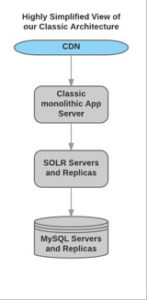How Bazaarvoice moved 300 million shoppers to a new generation platform Part 1
{This is the first in a 3 part series of posts intended to tell an impressive story of how we have been able to achieve an epic rearchitecture of our core platform. Special thanks to all of those who have helped in review and editing the original white paper.}
At Bazaarvoice, we’ve pulled off an incredible feat, one that is such an enormous task that I’ve seen other companies hesitate to take on. We’ve learned a lot along the way and I wanted to share some of these experiences and lessons in hopes they may benefit others facing similar decisions.
The Beginning
Our original Product Ratings and Review service served us well for many years, though eventually encountered severe scalability challenges. Several aspects we wanted to change: a monolithic Java code base, fragile custom deployment, and server-side rendering. Creative use of tenant partitioning, data sharding and horizontal read scaling of our MySQL/Solr based architecture allowed us to scale well beyond our initial expectations. We’ve documented how we have accomplished this scaling on our developer blog in several past posts if you’d like to understand more. Still, time marches on and our clients have grown significantly in number and content over the years. New use cases have come along since the original design: emphasis on the mobile user and responsive design, accessibility, the emphasis on a growing network of consumer generated content flowing between brands and retailers, and the taking on of new social content that can come in floods from Twitter, Instagram, Facebook, etc.
As you can imagine, since the product ratings and reviews in our system are displayed on thousands of retailer and brand websites around the world, the read traffic from review display far outweighs the write traffic from new reviews being created. So, the addition of clusters of Solr servers that are highly optimized for fast queries was a great scalability addition to our solution.
A highly simplified diagram of our classic architecture:
However, in addition to fast review display when a consumer visited a product page, another challenge started emerging out of our growing network of clients. This network is comprised of Brands like Adidas and Samsung who collect reviews on their websites from consumers who purchased the product and then want to “syndicate†those reviews to a set of retailer ecommerce sites where shoppers can benefit from them. Aside from the challenges of product matching which are very interesting, under the MySQL architecture this could mean the reviews could be copied over and over throughout this network. This approach worked for several years, but it was clear we needed a plan for the future.
As we grew, so did the challenge of an expanding volume of data in the master databases to serve across an expanding network of clients. This, together with the need to deliver more front-end web capability to our customers, drove us to what I hope you will find is a fascinating story of rearchitecture.
